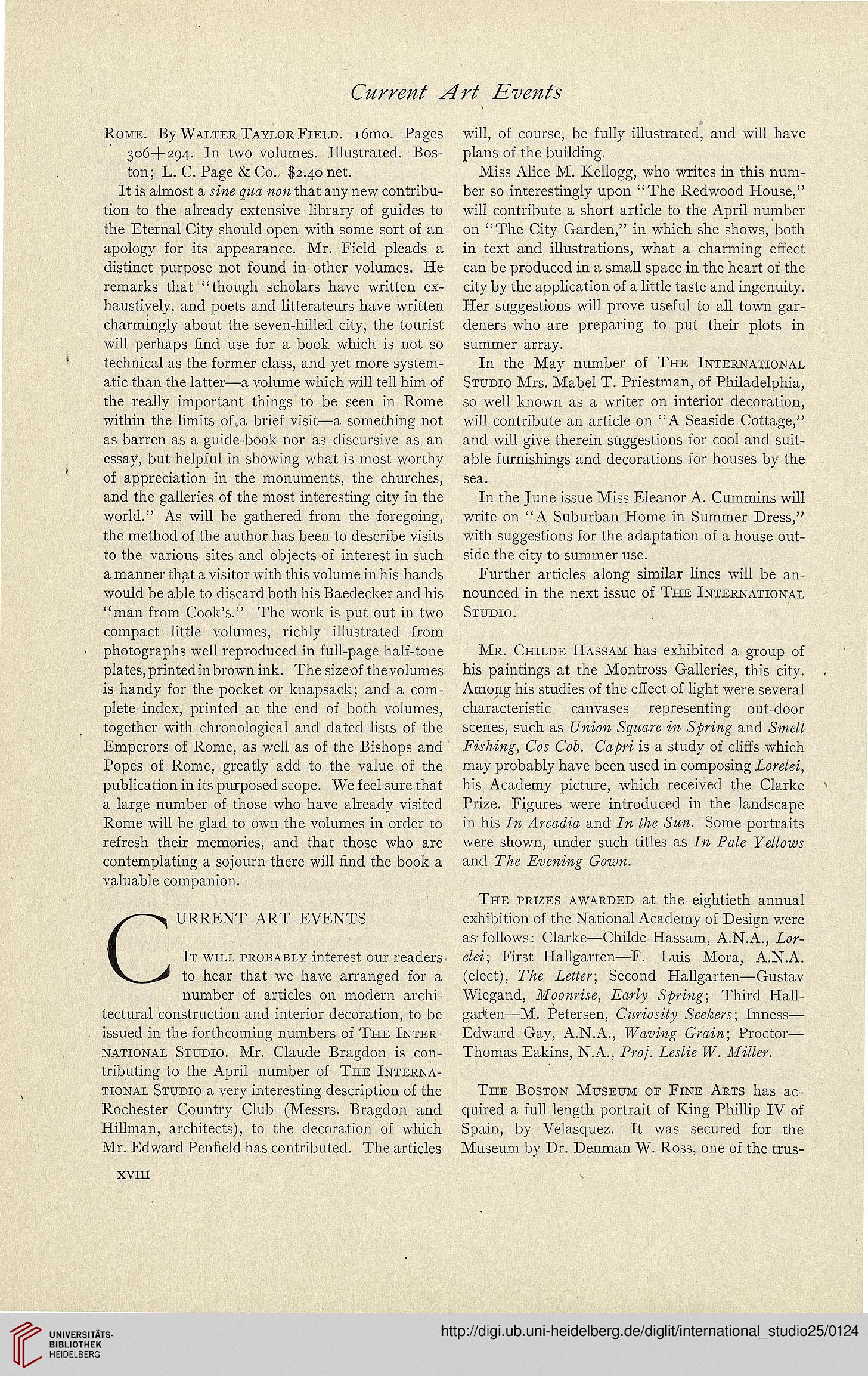ROME. By WALTER TAYLOR FiEiD. i6mo. Pages
306-{-2^4. In two volumes. Illustrated. Bos-
ton; L. C. Page & Co. $2.40 net.
It is almost a yme Mow that any new contribu-
tion to the already extensive library of guides to
the Eternal City should open with some sort of an
apology for its appearance. Mr. Field pleads a
distinct purpose not found in other volumes. He
remarks that "though scholars have written ex-
haustively, and poets and litterateurs have written
charmingly about the seven-hilled city, the tourist
will perhaps End use for a book which is not so
technical as the former class, and yet more system-
atic than the latter—a volume which will tell him of
the really important things to be seen in Rome
within the limits oLa brief visit—a something not
as barren as a guide-book nor as discursive as an
essay, but helpful in showing what is most worthy
of appreciation in the monuments, the churches,
and the galleries of the most interesting city in the
world." As will be gathered from the foregoing,
the method of the author has been to describe visits
to the various sites and objects of interest in such
a manner that a visitor with this volume in his hands
would be able to discard both his Baedecker and his
"man from Cook's." The work is put out in two
compact little volumes, richly illustrated from
photographs well reproduced in full-page half-tone
plates, printed in brown ink. The size of the volumes
is handy for the pocket or knapsack; and a com-
plete index, printed at the end of both volumes,
together with chronological and dated lists of the
Emperors of Rome, as well as of the Bishops and
Popes of Rome, greatly add to the value of the
publication in its purposed scope. We feel sure that
a large number of those who have already visited
Rome will be glad to own the volumes in order to
refresh their memories, and that those who are
contemplating a sojourn there will And the book a
valuable companion.
URRENT ART EVENTS
H IT WILL PROBABLY interest our readers
^ to hear that we have arranged for a
number of articles on modern archi-
tectural construction and interior decoration, to be
issued in the forthcoming numbers of THE INTER-
NATIONAL STUDIO. Mr. Claude Bragdon is con-
tributing to the April number of THE INTERNA-
TIONAL STUDIO a very interesting description of the
Rochester Country Club (Messrs. Bragdon and
Hillman, architects), to the decoration of which
Mr. Edward Penfteld has contributed. The articles
will, of course, be fully illustrated, and will have
plans of the building.
Miss Alice M. Kellogg, who writes in this num-
ber so interestingly upon "The Redwood House,"
will contribute a short article to the April number
on "The City Garden," in which she shows, both
in text and illustrations, what a charming effect
can be produced in a small space in the heart of the
city by the application of a little taste and ingenuity.
Her suggestions will prove useful to all town gar-
deners who are preparing to put their plots in
summer array.
In the May number of THE INTERNATIONAL
STUDIO Mrs. Mabel T. Priestman, of Philadelphia,
so well known as a writer on interior decoration,
will contribute an article on "A Seaside Cottage,"
and will give therein suggestions for cool and suit-
able furnishings and decorations for houses by the
sea.
In the June issue Miss Eleanor A. Cummins will
write on "A Suburban Home in Summer Dress,"
with suggestions for the adaptation of a house out-
side the city to summer use.
Further articles along similar lines will be an-
nounced in the next issue of THE INTERNATIONAL
STUDIO.
MR. CHiLDE HASSAM has exhibited a group of
his paintings at the Montross Galleries, this city.
Among his studies of the effect of light were several
characteristic canvases representing out-door
scenes, such as C?MOM fM F^riM^ and NweF
CM Cc&. Ca/w is a study of cliSs which
may probably have been used in composing Fore/ef,
his Academy picture, which received the Clarke
Prize. Figures were introduced in the landscape
in his Fn /lrcadfa and I*M Fro 6*MM. Some portraits
were shown, under such titles as 7% PaZe TeFowx
and FAo PvoMiM^ Goww.
THE PRIZES AWARDED at the eightieth annual
exhibition of the National Academy of Design were
as follows: Clarke—Childe Hassam, A.N.A., For-
g/gf; First Hallgarten—F. Luis Mora, A.N.A.
(elect), FAe FeMor; Second Hallgarten—Gustav
Wiegand, dFooMrije, FarAy F/wig; Third Hall-
garten—M. Petersen, Carfo^iAy AeeAory; Inness—
Edward Gay, A.N.A., IFaviMg' GraFi; Proctor—
Thomas Eakins, N.A., Fro/. F&yFe IF. dFP/or.
THE BOSTON MUSEUM OF FiNE ARTS has ac-
quired a full length portrait of King Phillip IV of
Spain, by Velasquez. It was secured for the
Museum by Dr. Denman W. Ross, one of the trus-
XVIII




